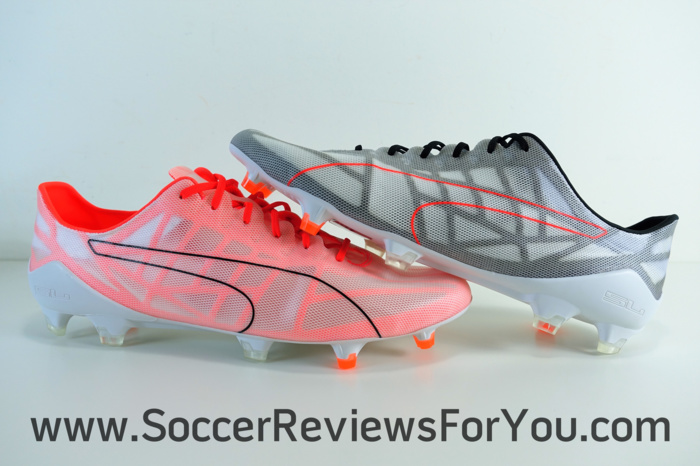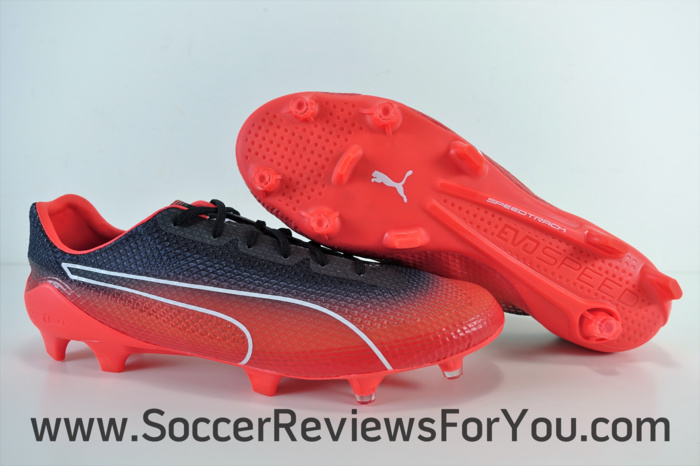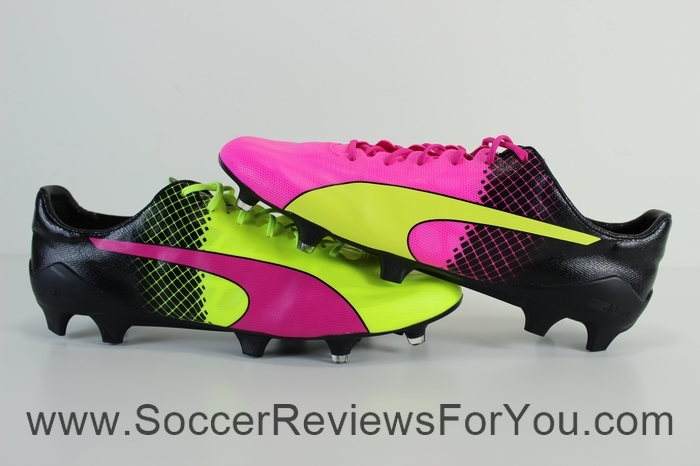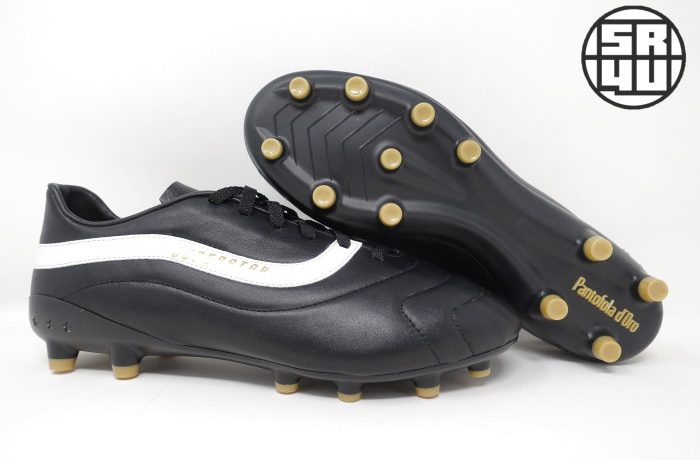Leather “Speed” boots seem to be falling off in popularity over the last year and a half or so, but that hasn’t stopped Puma from giving us a leather variation of the evoSPEED 1.3. In comparison to the leather evoSPEED 1.2, Puma has made some pretty significant changes that in my opinion, make for a better shoe overall.
Comfort/Fit
One reason why many people still prefer natural leather over thin synthetics, is not only due to the touch it provides, but also because it can often be more comfortable. In comparison to the synthetic evoSPEED 1.3, the leather version is in my opinion more comfortable, but it also doesn’t fit quite as tight.
Unlike the leather evoSPEED 1.2, a boot which featured an upper almost entirely made from calfskin leather, the 1.3 features calfskin leather in combination with synthetic, providing a different feel in comparison to its predecessor. The leather itself is much nicer on the 1.3 in comparison to the 1.2. While it’s calfskin as opposed to kangaroo leather, the quality is still very good, providing a nice soft touch on the ball, and an equally soft, comfortable fit.
While the upper is no longer made entirely from leather, something that may be viewed as a negative, the leather that you do get is in all the right spots, mostly. The leather spans the entire forefoot and toe area, the front half of the mid-foot on the medial side of the boot, as well as the heel. You’ll find synthetic pieces stitched to the edges of the leather spanning the lateral side of the upper, the rear portion of the mid-foot on the medial side, as well as the tongue. What’s unique about the construction is that while there are synthetic pieces on the upper, the bottom edge, where the upper meets the sole, is always leather. This is great because it allows the shoe to stretch on all areas of the foot, allowing for a very custom fit after break-in and a more natural feel overall.
The synthetic itself is a similar thickness to the leather portions of the upper, and is also quite flexible, so unlike many leather/synthetic hybrid shoes, you don’t really feel or notice that there is synthetic featured on the upper at all.
The soleplate and heel counter combo, along with the stud pattern, remains completely unchanged coming from the 1.2, which is not a bad thing. Its base is a thin, flexible thermoplastic elastomer, with a Pebax “Speedtrack” stiffener running through the mid-foot and heel. The soleplate is flexible in the forefoot, and significantly stiffer in the mid-foot, making for a very smooth and natural running experience. If I had one complaint about the soleplate, it would be that it’s a little thin for use on harder playing surfaces. The firm ground studs are quite long and narrow, so when you are on harder ground where the studs can’t dig in, stud pressure can become a minor issue.
The heel is lined with a smooth synthetic material, backed by a decent amount of padding considering the lightweight feel of the boot, allowing for a comfortable and locked-in feel. The insole is also removable, and aside from having different graphics on top, is the same as the evoSPEED 1.2. It features a mesh top layer, backed by a thin layer of foam, with a thick layer of perforated foam inserted under the heel and forefoot. It makes for great step in comfort, but note that it will compress and become much less padded as the shoes are worn in.
Break-in is pretty straight forward. The boots feel great from out of box, but give them a couple hours of wear-time and you’ll find that the leather upper softens up significantly. The shoe has a tighter fit at first, but stretches quite a bit, especially in the forefoot and toe box area, so if they fit a little snug when they’re new, give them some time to break-in and they’ll feel a lot better.
The fit of the boot is similar, but certainly not the same as the synthetic evoSPEED 1.3. The leather upper, especially once it has stretched out a bit, offers a snug fit, but doesn’t provide that second-skin feel that you would get from a thin synthetic upper. This shoe feels a lot more like a traditional leather soccer shoe when it comes to comfort, but with a tighter, more locked in fit through the mid-foot due to the synthetic pieces. The boot also retains Puma’s signature anatomical shape, where the toe isn’t rounded, but instead comes to a bit of a point at the big toe, and then curves around, mimicking the shape of an actual foot.
The anatomical shape is one of those features that seem to scare away a lot of people when it comes to choosing Puma as their next boot. Yes, it feels a little different on feet in comparison to something with a perfectly rounded toe, but when it comes to actually playing in the shoes, it isn’t something that I really notice at all. I didn’t have any issues at all adjusting to the shape of the boot, and I think most people wouldn’t either. If anything, the anatomical shape is a major positive for this boot in that it helps to eliminate any extra dead space inside the boot, offering more a of a one-to-one sensation when you have these shoes on your feet.
Width-wise, the leather evoSPEED 1.3 is suitable for most foot types. The leather upper will stretch quite a bit, especially in the forefoot and toe box, allowing the shoe to stretch to the exact shape of your foot. I have average width feet and am also slightly flat footed, and these fit me great.
In terms of sizing, just like the evoSPEED 1.2, the 1.3 also runs half a size small. Instead of wearing my usual size 9US, and went up half a size to a 9.5US for the proper fit. So, to keep things simple, if you’re coming from any of the previous evoSPEED models, or even the evoPOWER 1, stick with the same size, where as if you’re coming from most other shoes, I would recommend going half a size up.
Weight
In terms of weight, the leather evoSPEED 1.3 is light, almost as light as the synthetic version, which is somewhat surprising. In a size 9.5US, the synthetic evoSPEED 1.3 weighs in at 7oz, where the leather version weighs in at 7.4oz. With a difference of 0.4oz, the leather evoSPEED 1.3 feels every bit as light both in-hand and on feet when compared to the synthetic model, so if you were trying to decide between the two versions, weight should not be the deciding factor.
For comparison sake, the current leather Adidas F50 adizero, in the same size, weighs in at 6.7oz, which is a touch lighter than the evoSPEED 1.3. With that said, the evoSPEED features significantly more leather on the upper in comparison F50, which must be taken into consideration if you’re looking for that soft leather feel.
Traction
As mentioned earlier, the soleplate and stud pattern combo remains unchanged from the evoSPEED 1.2. The stud pattern is made up of all conical studs that are quite long, and narrow in profile. You’ll find four studs under the heel, and 8 total studs in the forefoot, 3 on the medial side, 4 on the lateral side and 1 in the middle. The rounded shape of the studs allows you to very easily twist and pivot when planted, while the narrow profile allows them to dig in quite aggressively, providing tons of grip when pushing off in all directions.
The flexibility of the soleplate in the forefoot, largely due to the fact that it’s quite thin and also features some pretty significant flex grooves, allows you to have as many studs under your feet as possible at all times, no matter which way twist or turn.
One aspect of this stud pattern that is somewhat unique is the length of the studs. For a firm ground stud pattern, the studs are quite long, and also don’t seem to vary in length, so all of the studs are exactly the same height. This is a stud pattern that will perform amazingly well and is ideal for really nice, natural grass fields, ranging from firm to soft. If you find yourself playing frequently on firm and soft ground, the longer studs on the evoSPEED are well suited for both playing surfaces.
As mentioned earlier, because the studs are longer and soleplate is quite thin, stud pressure can be a minor issue if you’re going to be using these on harder natural grass playing surfaces. The issue is not to the point where the shoes become so uncomfortable that you can’t wear them on harder surfaces at all, but you will notice some slight pressure under your feet, which can become more and more uncomfortable over time.
Touch
The main reason why you would opt for the leather version of the evoSPEED 1.3 is to have that classic leather touch on the ball, and you get exactly that, mostly. The leather itself is soft, flexible, and a nice thickness, providing a premium leather touch on the ball in the toe box, forefoot and mid-foot area of the foot. There are graphics printed on certain parts of the upper, but those graphics are purely cosmetic and do not provide any extra grip on the ball. It’s a very no nonsense leather feel, which is more or less what I was looking for.
My one complaint is the tongue, not because it’s bad, but because I would have preferred something else. The tongue is made from the same thin synthetic material found on the synthetic version of the evoSPEED 1.3. Needless to say, the thin tongue does not offer the same padded touch on the ball that you get from the rest of the boot. This is particularly noticeable when juggling and shooting the ball, taking away from that classic leather feel that you expect from this type of shoe. Of course this is just me picking out small details that I would have done differently, and not something that is detrimental to the overall performance. Some may even like the thinner tongue.
If you’re looking for a lightweight boot that offers a soft leather touch on the ball with a slightly modern twist, then you’ll really enjoy the leather evoSPEED 1.3.
Shooting
When it comes to shooting the ball, there isn’t much to explain. You get a padded sensation from the leather when striking the ball with the forefoot or mid-foot, and a thinner, more responsive sensation when striking the ball with the laces due to the synthetic tongue. There’s no extra grip on the ball either. If you’ve worn straight up leather shoes in the past, these will feel very similar, just a little lighter.
Protection
The protection on offer here is a little above average in comparison to a lot of shoes in this weight range, but still not to the point where I would call it overly protective. The leather upper does have some decent thickness to it, but it’s quite soft, so should you get stepped on, there’s some protection, but not much. The top of the foot, where the tongue is located, is even more vulnerable, being made from thin synthetic as opposed to padded leather. The boot also features an external plastic heel counter, which will provide some protection against kicks to the back of heel.
There isn’t a ton of protection here, but considering the weight of the boot, they’re not bad.
Durability
As far as durability is concerned, the leather evoSPEED 1.3 seems to be pretty good. I’ve got quite a bit of playing time on the pair that I wore for testing, and while they are noticeably worn, everything is still intact. The leather has stretched, but not too much, and some of the stitching across the leather has started to fray, but that is relatively normal wear for a leather soccer cleat. If there’s one thing that worries me it’s the very low-profile edge of the soleplate. I doesn’t lip up at all, which is fine for a synthetic upper, but arguably not the best for a leather upper.
Again, nothing has gone wrong with the pair I wore for testing, but there is noticeable wear. This is shoe that should pretty easily get you through a season’s worth of play, if not longer, just make sure you take good care of them. They’re leather, so regular maintenance is required if you want to keep them in optimal condition.
Please keep in mind that the FG version of the evoSPEED 1.3m or any FG shoe for that matter, is designed for use on natural grass only. Using any FG cleat on artificial grass/turf will have a major impact on the overall durability and longevity of your shoes.
The Verdict
I love wearing leather soccer cleats, and I really enjoyed my time with the evoSPEED 1.3. With that being said, I can’t say that the little bit of weight savings that this shoe offers was pulling me away from other no so lightweight leather options like the Nike Tiempo Legend 5, but maybe that’s just me.
If you like the feel of leather, and you absolutely must have a lightweight shoe, than the evoSPEED 1.3 is one of the best options on the market that will meet your needs. It features more leather than any other boot in this category, offers a great fit, a comfortable feel and awesome traction.
It certainly isn’t the best leather shoe that I’ve ever worn, in fact not even close, but if the combination of features that the evoSPEED 1.3 has to offer appeals to you, than this is a very solid option.
| Comfort/Fit | 9 out of 10 |
| Weight | 8 out of 10 |
| Traction | 9 out of 10 |
| Touch | 8 out of 10 |
| Shooting | 8 out of 10 |
| Protection | 7 out of 10 |
| Durability | 7 out of 10 |
| FINAL SCORE | 56 out of 70 or 80% |








